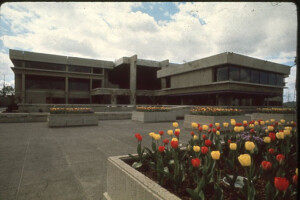The Development of Salem’s Civic Center
In the summer of 1968, then-mayor Vern Miller launched a campaign for a bond election on a Salem Civic Center, composed of a city hall, library, police and central fire station.
A similar measure had been defeated by the voters two years earlier. Mayor Miller was advised against bringing the issue back to the voters so soon. But a property tax limitation was scheduled for the Fall ballot, and the mayor feared that if it passed, it would block any civic center campaign for the foreseeable future.
Salem’s city hall had been built in the 1890s for a city of 4,000. Its public library was built in 1914 and had only 4 parking spaces. At this time, Salem’s population was over 60,000 people. Additionally, city services were scattered in satellite offices due to the size limitations of the existing city hall and the need to provide services to the growing population. Clearly, new civic buildings were needed.
To defuse the idea that the civic center initiative was coming from city government, Mayor Miller appointed a 26-member campaign committee composed of people who were not identified with city politics. He asked Wes Sullivan, news editor of The Oregon Statesman newspaper, to be chairman.
The first committee meeting was held on a sweltering summer night in a crowded room in the old city hall, with Sullivan asking his new committee members to mark a date on their calendars in 1972 when they would hold a victory dinner in the auditorium of the new Salem Public Library.
The City Council vowed to let the new committee have full control over the campaign. Gerry Frank was finance chairman of the campaign. He was asked to raise $8,200 which he promptly did. Thus, the campaign had buttons, fliers and all the fiscal help it needed. The committee started by using a city bus to tour nine possible sites for the new civic center complex. The almost unanimous conclusion was to build the civic center south from the downtown area between Commercial and Liberty streets. This was the site favored by Mayor Miller too. However, it was also the site rejected by the voters at the previous election. The lone committee member opposing that site was Bill Mainwaring, the editor and publisher of the Capital Journal newspaper. He wanted a site along Mill Creek, on the north side of the downtown. This posed a problem for the committee. To override him was to risk opposition from one of the two local daily newspapers.
As a compromise, the committee decided to put both sites on the ballot and let the voters decide on the site was well as on the $6 million bond issue to fund the new civic center. The City Council, while favoring the southern site, agreed to abide by the voters’ decision.
Summer normally is a bad time to run an election campaign, but the summer of 1968 was full of campaign activity. Again, in an attempt to make it a “grass roots” effort, it was decided to hold block parties in each of the 1,400 blocks in Salem, to invite public comment and participation.
Fifty Long Play records were cut of Mayor Miller’s appeal to the voters. Huge drop cards were printed showing the proposed buildings that were shown to accompany the recorded message from the Mayor. Campaign representatives volunteered to attend each block party. It turned out that people didn’t want their neighbors inside their homes, so only 100 block parties were held. But the effort paid off in convincing the public that the campaign was sincere in asking voter opinion.
The election had to be held on the 30th of September, in order to allow time for the bonds to be sold before the Fall election and the possible imposition of the property tax limitation. As the date approached, the earlier pessimism turned to optimism. A Jaycee poll showed that voters were ready to accept the bond issue. It was noted by some cynics that getting the public to debate which of two sites for the civic center assumed the passage of the bond issue itself.
When the votes were counted, the bond issue had passed by about 8,000 to 5,000, and the southern site was selected. (It turned out that voters chose the site closest to where they lived, and there were more votes in the south of Salem than in the north.)
The campaign had promised civic center buildings faced with stone and wood. It turned out that there was money enough only for concrete facing, and even with that, there wasn’t enough bond money to fully equip the buildings. So a second campaign, for another $2.2million had to be launched a year or two later.
However, all the records from the initial campaign were available, including the names of the thousands of people who had supported the earlier campaign. The get-out-the-vote campaign focused on those supporters, and the supplemental funds were approved.
The Civic Center “anchor on the south” of the Salem downtown also resulted in a sweeping urban renewal of areas to the east of the Civic Center, all the way to Willamette University. In 1970, a major restudy of the downtown was initiated, leading to the sky bridges and the riverfront park.
The Salem Civic Center, 30 years old as of this writing, became the keystone in building one of the most beautiful and functional city centers in Oregon.
Written by Wes Sullivan
Bibliography:
Personal knowledge of the civic center complex campaign by its Chairman, Wesley Sullivan written, June, 2002
This article originally appeared on the original Salem Online History site and has not been updated since 2006.








Leave A Comment